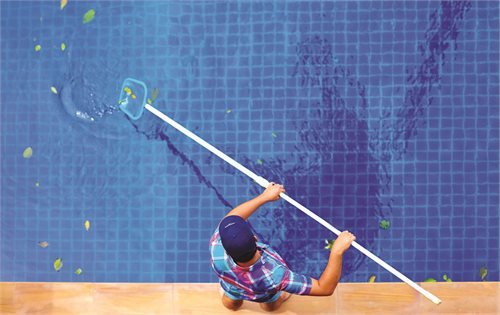Tips to prepare your pool for winter
As the temperature begins to drop in Australia, it's time to start thinking about preparing your pool for winter. Winterizing your pool correctly can help to prevent damage and save you money when it's time to reopen your pool for the summer. In this blog post, we'll provide you with some tips on how to get your fiberglass pool ready for the colder weather. We'll cover which chemicals to use, how to prepare your pool equipment, and how to cover your pool.
By following these tips, you can ensure that your pool is protected and ready to face the winter months:
Clean the pool thoroughly
Before you start the process of winterizing your pool, it's important to give it a thorough clean. Use a net to remove any leaves, insects or other debris that may have accumulated on the surface of the water. You should also brush the sides and bottom of the pool to remove any dirt or algae buildup.It's important to remove all debris from the pool before winter, as this will help to prevent staining and make it easier to balance the chemicals in the water. If you leave debris in the pool over winter, it can break down and create an ideal environment for bacteria and algae to grow. So, take the time to clean your pool thoroughly before proceeding with the rest of the winterization process.
Balance the chemicals
One of the most important steps in preparing your pool for winter is to make sure that the chemical balance is correct. The first step is to test the water to determine the current chemical levels. You can use a test kit to measure the pH, alkalinity, calcium hardness and chlorine levels. Alternatively, you can bring a water sample to us in-store, where they can test it for you and provide advice on the best chemicals to use.Kill of any Algae
An algae treatment works by destroying algae cells in the water, preventing them from growing and multiplying. This can help to keep the water clear and healthy throughout the winter months, making it easier to reopen your pool in the spring. There are many different types of algae treatments available, including chlorine-based treatments, copper-based treatments and non-toxic treatments. We can help you to choose the best product for your pool, based on factors such as the type of algae that is common in your area and the level of treatment required.Clean the filter, other equipment & skimmer baskets
Cleaning your pool's filter, skimmer baskets, and pump lint baskets is an important step in preparing your pool for winter. Over time, these components can become clogged with debris, which can affect the flow of water through the system and lead to damage. Any grease, oil or scale deposits may harden over winter and it's a quick and easy task that can save you money and keep your pool in good condition for not only winter, but for years to come.Clean your pool accessories
It's important to clean and store any accessories, such as pool toys, pool cleaners, and pool covers. These accessories can accumulate dirt and debris over time, which can lead to mold and mildew growth if they are not cleaned properly. To clean pool accessories, simply give them a rinse with a hose and allow them to dry in the sun. Make sure to store them away when not in use in a clean, dry area.Cover the pool
Covering your pool is an important step in preparing it for winter. A pool cover helps to protect the water from leaves, debris, and other contaminants, which can accumulate in the water and make it difficult to clean when you reopen the pool in the spring. Make sure the cover is tight and there are no cracks or gaps.Reduce the pool system running time
During winter, you don't need to run your pool's filtration system as often as you would during the summer months. In fact, reducing your pool's system running time to 3-4 hours per day is usually sufficient. This can help to reduce energy costs and save you money on your electricity bill. In addition to reducing the system running time, it's also important to reduce the amount of chlorine that your pool system is outputting. This is because colder temperatures and reduced sunlight can cause chlorine levels to remain high, which can damage the pool's interior finish over time.Check your pool & water every 2-3 weeks
Even though you have taken all the necessary steps to winterize your pool, it's important to check on it every 2-3 weeks to ensure that it's still in good condition. This means checking the pool and water for any signs of leaves, debris, or algae growth, and making sure that the water is still balanced correctly.If you notice any leaves or debris on the pool cover, make sure to remove them immediately to prevent them from entering the water. You should also check the water chemistry levels to ensure that they are still within the recommended range. If you notice that the water chemistry levels are off or that algae growth has started, it's important to take action immediately. You can use an algaecide or shock treatment to help eliminate any algae growth and restore the water chemistry balance.
By checking on your pool and water every 2-3 weeks, you'll be able to catch any issues early on and prevent them from getting worse. This will make it easier to reopen your pool in the spring and ensure that it's in good condition for swimming.
Preparing your fibreglass pool for winter is an essential step to protect it from damage caused by harsh weather conditions. In this blog post, we have covered eight tips to help you winterize your pool properly. These include cleaning the pool, balancing the water chemistry, adding an algae treatment, cleaning the filter and accessories, covering the pool, reducing the system running time, and checking on the pool and water every 2-3 weeks.
By following these tips, you can ensure that your pool is ready for winter and remains in good condition until it's time to reopen it in the spring. Don't hesitate to contact us for any additional advice or assistance with winterizing your fibreglass pool. Stay ahead of the game and prepare your pool for winter with these simple and effective tips.



